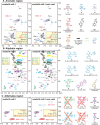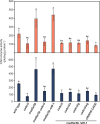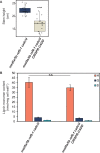H-lignin can be deposited independently of CINNAMYL ALCOHOL DEHYDROGENASE C and D in Arabidopsis
- PMID: 35522042
- PMCID: PMC9342963
- DOI: 10.1093/plphys/kiac210
H-lignin can be deposited independently of CINNAMYL ALCOHOL DEHYDROGENASE C and D in Arabidopsis
Abstract
Lignin contributes substantially to the recalcitrance of biomass toward saccharification. To circumvent this problem, researchers have genetically altered lignin, although, in a number of cases, these efforts have resulted in an undesirable yield penalty. Recent findings have shown that by knocking out two subunits (MED5A and MED5B) of the transcriptional regulatory complex Mediator, the stunted growth phenotype of mutants in p-coumaroyl shikimate 3'-hydroxylase, reduced epidermal fluorescence 8-1 (ref8-1), can be alleviated. Furthermore, these plants synthesize a lignin polymer almost entirely derived from p-coumaryl alcohol. Plants deficient in cinnamyl alcohol dehydrogenase (CAD) are notable in that they primarily incorporate coniferaldehyde and sinapaldehyde into their lignin. We tested the hypothesis that by stacking mutations in the genes encoding for the CAD paralogs C and D on an Arabidopsis (Arabidopsis thaliana) med5a/5b ref8-1 genetic background, the biosynthesis of p-coumaryl alcohol would be blocked, making p-coumaraldehyde available for polymerization into a novel kind of lignin. The med5a/5b ref8-1 cadc cadd plants are viable, but lignin analysis demonstrated that they continue to synthesize p-hydroxyphenyl lignin despite being mutated for the CADs typically considered to be required for monolignol biosynthesis. In addition, enzyme activity tests showed that even in the absence of CADC and CADD, there is high CAD activity in stems. We tested the potential involvement of other CADs in p-coumaraldehyde biosynthesis in the quintuple mutant by mutating them using the CRISPR/Cas9 system. Lignin analysis demonstrated that the resulting hextuple mutant plants continue to deposit p-coumaryl alcohol-derived lignin, demonstrating a route for the synthesis of p-hydroxyphenyl lignin in Arabidopsis independent of four CAD isoforms.
© American Society of Plant Biologists 2022. All rights reserved. For permissions, please email: journals.permissions@oup.com.
Figures









Comment in
-
Yet another twist in lignin biosynthesis: Is there a specific alcohol dehydrogenase for H-lignin production?Plant Physiol. 2022 Aug 1;189(4):1884-1886. doi: 10.1093/plphys/kiac249. Plant Physiol. 2022. PMID: 35639729 Free PMC article. No abstract available.
Similar articles
-
Manipulation of Guaiacyl and Syringyl Monomer Biosynthesis in an Arabidopsis Cinnamyl Alcohol Dehydrogenase Mutant Results in Atypical Lignin Biosynthesis and Modified Cell Wall Structure.Plant Cell. 2015 Aug;27(8):2195-209. doi: 10.1105/tpc.15.00373. Epub 2015 Aug 11. Plant Cell. 2015. PMID: 26265762 Free PMC article.
-
Disruption of Mediator rescues the stunted growth of a lignin-deficient Arabidopsis mutant.Nature. 2014 May 15;509(7500):376-80. doi: 10.1038/nature13084. Epub 2014 Mar 16. Nature. 2014. PMID: 24670657
-
Expression pattern of two paralogs encoding cinnamyl alcohol dehydrogenases in Arabidopsis. Isolation and characterization of the corresponding mutants.Plant Physiol. 2003 Jun;132(2):848-60. doi: 10.1104/pp.103.021048. Plant Physiol. 2003. PMID: 12805615 Free PMC article.
-
Trends in lignin modification: a comprehensive analysis of the effects of genetic manipulations/mutations on lignification and vascular integrity.Phytochemistry. 2002 Oct;61(3):221-94. doi: 10.1016/s0031-9422(02)00211-x. Phytochemistry. 2002. PMID: 12359514 Review.
-
[Advances in research on lignin biosynthesis and its genetic engineering].Zhi Wu Sheng Li Yu Fen Zi Sheng Wu Xue Xue Bao. 2004 Aug;30(4):361-70. Zhi Wu Sheng Li Yu Fen Zi Sheng Wu Xue Xue Bao. 2004. PMID: 15627683 Review. Chinese.
Cited by
-
Pinoresinol rescues developmental phenotypes of Arabidopsis phenylpropanoid mutants overexpressing FERULATE 5-HYDROXYLASE.Proc Natl Acad Sci U S A. 2023 Aug;120(31):e2216543120. doi: 10.1073/pnas.2216543120. Epub 2023 Jul 24. Proc Natl Acad Sci U S A. 2023. PMID: 37487096 Free PMC article.
-
Yet another twist in lignin biosynthesis: Is there a specific alcohol dehydrogenase for H-lignin production?Plant Physiol. 2022 Aug 1;189(4):1884-1886. doi: 10.1093/plphys/kiac249. Plant Physiol. 2022. PMID: 35639729 Free PMC article. No abstract available.
-
Systematic approaches to C-lignin engineering in Medicago truncatula.Biotechnol Biofuels Bioprod. 2023 Jun 12;16(1):100. doi: 10.1186/s13068-023-02339-7. Biotechnol Biofuels Bioprod. 2023. PMID: 37308891 Free PMC article.
-
Strigolactones positively regulate Verticillium wilt resistance in cotton via crosstalk with other hormones.Plant Physiol. 2023 May 31;192(2):945-966. doi: 10.1093/plphys/kiad053. Plant Physiol. 2023. PMID: 36718522 Free PMC article.
-
Simultaneous Down-Regulation of Dominant Cinnamoyl CoA Reductase and Cinnamyl Alcohol Dehydrogenase Dramatically Altered Lignin Content in Mulberry.Plants (Basel). 2024 Dec 16;13(24):3512. doi: 10.3390/plants13243512. Plants (Basel). 2024. PMID: 39771210 Free PMC article.
References
-
- Anderson NA, Tobimatsu Y, Ciesielski PN, Ximenes E, Ralph J, Donohoe BS, Ladisch M, Chapple C (2015) Manipulation of guaiacyl and syringyl monomer biosynthesis in an Arabidopsis cinnamyl alcohol dehydrogenase mutant results in atypical lignin biosynthesis and modified cell wall structure. Plant Cell 27: 2195–2209 - PMC - PubMed
-
- Bonawitz ND, Kim JI, Tobimatsu Y, Ciesielski PN, Anderson NA, Ximenes E, Maeda J, Ralph J, Donohoe BS, Ladisch M, et al. (2014) Disruption of Mediator rescues the stunted growth of a lignin-deficient Arabidopsis mutant. Nature 509: 376–380 - PubMed
Publication types
MeSH terms
Substances
LinkOut - more resources
Full Text Sources
Molecular Biology Databases
Miscellaneous

